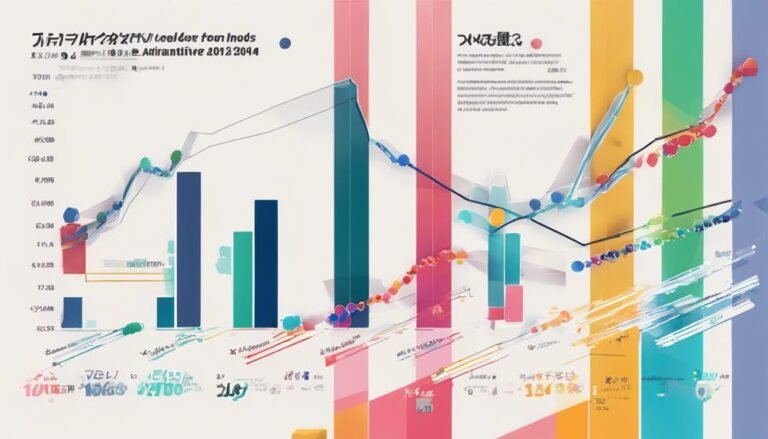Exploring Trends in Quant Research Papers
The field of quantitative research is constantly evolving, with new trends and methodologies emerging. In this article, we will delve into the latest advances and methodologies detailed in cutting-edge Quant Research Papers across diverse data-centric fields.
Key Takeaways:
- Quantitative research papers play a vital role in advancing our understanding of data-centric fields.
- These papers contribute to the development of statistical research methods and empirical studies.
- Quantitative analysis papers provide insights into complex phenomena and help make data-driven decisions.
- Researchers collaborate across disciplines to integrate quantitative methods with qualitative insights.
- Data analysis journals serve as platforms for sharing research findings and promoting innovation in quantitative research.
Big Data and Analytics
One of the most prominent trends in quantitative research is the utilization of big data and analytics to extract valuable insights from large and complex datasets. In today’s digital age, the volume, variety, velocity, and veracity of data generated from various sources are unprecedented. Big data encompasses the massive amount of information continuously being created and collected, providing researchers with a treasure trove of data to explore and analyze.
Analytics, on the other hand, involves applying statistical, computational, and visual methods to process and interpret big data. Through the use of sophisticated algorithms and techniques, researchers can derive meaningful patterns, trends, and correlations from these vast datasets. This allows for a more comprehensive understanding of complex research questions and aids in optimizing decision-making processes.
Big data and analytics have revolutionized quantitative research by enabling researchers to address novel research questions that were previously unanswerable due to data limitations. Furthermore, this trend has unlocked opportunities for researchers to explore uncharted territories and make data-driven decisions based on robust quantitative analysis.
“The potential of big data and analytics in quantitative research is vast. These tools and methodologies provide researchers with the ability to uncover hidden patterns and relationships within the data, leading to groundbreaking insights and discoveries.”
The Impact of Big Data and Analytics
The integration of big data and analytics has wide-ranging implications across various industries and fields. Here are some key impacts:
- Data-Driven Decision Making: Big data analytics allows businesses and organizations to make informed decisions based on quantitative insights derived from large datasets.
- Personalized Customer Experiences: By analyzing big data, companies can gain a deep understanding of their customers’ preferences, enabling them to deliver personalized experiences and targeted marketing campaigns.
- Improved Healthcare Outcomes: Big data analytics in healthcare can enhance patient outcomes, optimize treatment plans, and enable early disease detection through predictive modeling.
- Efficient Operations: Analytics applied to big data can help organizations streamline their operations, identify inefficiencies, and optimize processes to increase productivity.
Big data analytics has become an indispensable tool in the fields of finance, marketing, healthcare, logistics, and many others. As technology continues to evolve and generate more data, the role of big data and analytics in quantitative research will only continue to grow.
Mixed Methods Research
Mixed methods research is an important trend in the field of quantitative research. It involves integrating both qualitative and quantitative methods to gain a comprehensive understanding of research phenomena. This approach recognizes the limitations of relying solely on one method and seeks to overcome them by combining different data collection and analysis techniques.
By incorporating qualitative methods, such as interviews, focus groups, and observations, researchers can gather in-depth insights and explore the context and meaning behind quantitative data. This qualitative component adds richness and depth to the findings, allowing for a more nuanced interpretation.
On the other hand, quantitative methods, such as surveys and statistical analysis, provide a structured and systematic approach to data collection and analysis. These methods enable researchers to quantify relationships, identify patterns, and test hypotheses, thereby enhancing the validity and reliability of the research.
“The integration of qualitative and quantitative methods in mixed methods research allows us to see the big picture while also capturing the intricate details.”
By combining the strengths of qualitative and quantitative methods, mixed methods research offers a comprehensive and holistic approach to understanding complex research phenomena. It allows researchers to triangulate findings, validate results, and gain a deeper understanding of the research topic.
Benefits of Mixed Methods Research:
- Enhanced validity and reliability of research findings
- Comprehensive understanding of research phenomena
- Opportunity to explore the context and meaning behind quantitative data
- Triangulation of findings for a more robust interpretation
- Integration of different perspectives and methodologies
Machine Learning and Artificial Intelligence
Artificial intelligence (AI) and machine learning have revolutionized the field of quantitative research, enabling researchers to extract valuable insights from vast amounts of data. Machine learning algorithms analyze data and make predictions or decisions based on patterns and relationships within the data. On the other hand, AI encompasses machine learning and other technologies aimed at creating intelligent systems.
Machine learning and AI have become indispensable tools for quantitative research, allowing researchers to uncover hidden patterns, generate hypotheses, and enhance the accuracy and efficiency of data analysis. These technologies have the potential to transform various industries, including finance, healthcare, and marketing.
“Machine learning is the foundation of artificial intelligence, enabling computers to learn from data and perform tasks without explicit programming.” – Andrew Ng
Applications in Quantitative Research
Machine learning and AI techniques have found applications in numerous areas of quantitative research, including:
- Predictive modeling: Using historical data to predict future outcomes and trends.
- Pattern recognition: Identifying complex patterns and correlations in data.
- Anomaly detection: Detecting unusual or abnormal data points that may indicate fraud or errors.
- Natural language processing: Analyzing and understanding human language data, such as text and speech.
- Recommender systems: Providing personalized recommendations based on user preferences and behavior.
By harnessing the power of machine learning and AI, researchers are able to tackle complex research questions and gain deeper insights into the behavior of systems and phenomena.
Advantages and Challenges
The integration of machine learning and AI in quantitative research offers several advantages:
- Enhanced efficiency: These technologies enable researchers to analyze large datasets quickly and accurately, saving time and resources.
- Improved accuracy: Machine learning algorithms can detect intricate patterns that may be overlooked by traditional statistical methods.
- Automation of tasks: AI systems can automate repetitive tasks, freeing up researchers’ time for more meaningful analysis and interpretation.
Despite the numerous benefits, there are also challenges associated with machine learning and AI in quantitative research. These include:
- Data quality and bias: Machine learning models heavily rely on the quality and representativeness of the data used for training, which can introduce biases.
- Interpretability: Machine learning algorithms often produce complex models that are difficult to interpret, making it challenging for researchers to explain the underlying rationale.
- Ethical considerations: The use of machine learning and AI raises ethical concerns such as privacy, fairness, and accountability.
Addressing these challenges is crucial to ensure the responsible and effective use of machine learning and AI in quantitative research.
Applications of Machine Learning and AI in Quantitative Research
| Application | Description |
|---|---|
| Predictive Modeling | Using historical data to forecast future outcomes or trends. |
| Pattern Recognition | Identifying complex patterns and correlations in large datasets. |
| Anomaly Detection | Detecting abnormal data points that may indicate fraud or errors. |
| Natural Language Processing | Processing and understanding human language data, such as text and speech. |
| Recommender Systems | Providing personalized recommendations based on user behavior and preferences. |
Machine learning and artificial intelligence have ushered in a new era of possibilities in quantitative research. Researchers can leverage these technologies to unlock valuable insights, drive innovation, and make data-driven decisions across various domains.
Data Visualization and Storytelling
Data visualization and storytelling play a crucial role in quantitative research, enabling researchers to effectively communicate their findings and engage their audience. Through the use of graphical elements such as charts, maps, and dashboards, data visualization allows researchers to present and explore complex data in a visually compelling manner.
By visually representing data, researchers can highlight patterns, trends, and relationships that might otherwise go unnoticed. This visual representation not only enhances the understanding of the data but also provides a means for individuals to interact with and interpret the information more easily.
Storytelling, on the other hand, goes beyond the visual representation of data and focuses on conveying the meaning and impact of the findings. By using narrative techniques, researchers can contextualize the data and create a compelling story around it. Storytelling adds a human element to the research, making it relatable and memorable.
Through the combination of data visualization and storytelling, researchers can effectively communicate the key messages and implications of their quantitative research. This approach allows them to engage with their audience on a deeper level, enabling them to connect with the research findings in a more meaningful way.
Furthermore, data visualization and storytelling are powerful tools for persuading individuals to take action based on the research findings. By presenting data in a visually appealing and impactful manner, researchers can inspire their audience to make informed decisions and drive positive change in their respective fields.
Overall, data visualization and storytelling are essential components of quantitative research. They facilitate effective communication, enhance understanding, and inspire action. By harnessing these tools, researchers can ensure that their findings have a lasting impact and contribute to the advancement of knowledge in their respective domains.
Ethical and Responsible Research
Conducting ethical and responsible research is a growing trend in quantitative research. This trend emphasizes respecting the rights, interests, and privacy of research participants, stakeholders, and society as a whole. Ethical and responsible research involves several key principles that researchers should adhere to:
- Obtaining informed consent: Researchers should ensure that participants have a clear understanding of the research objectives, procedures, risks, and benefits before agreeing to participate.
- Protecting privacy and confidentiality: Confidentiality should be maintained throughout the research process, and data should be stored securely to prevent unauthorized access.
- Ensuring data security and quality: Researchers should implement measures to protect data integrity, accuracy, and reliability, including secure storage, backup, and data validation procedures.
- Avoiding bias and plagiarism: Researchers should strive for objectivity and fairness in their research, avoiding any intentional or unintentional bias and properly acknowledging the work of others.
- Acknowledging sources and contributions: Researchers should properly attribute the ideas, data, and materials used in their research and acknowledge the contributions of others.
- Addressing potential risks and harms: Researchers should carefully consider the potential risks and harms associated with their research and implement appropriate safeguards to minimize these risks.
Adhering to these principles is crucial for maintaining the integrity and credibility of quantitative research. By conducting ethical and responsible research, researchers can contribute to scientific knowledge while upholding the rights and well-being of research participants and society as a whole.
“Ethical and responsible research is the cornerstone of reliable and trustworthy quantitative research. By conducting studies that prioritize the rights and well-being of participants, researchers can generate valuable insights that have a positive impact on society.”
The Importance of Ethical Research
Ethical research is essential for several reasons:
- Protecting participants: Ethical research ensures that participants are treated with dignity, respect, and fairness, and their rights and well-being are safeguarded.
- Ensuring scientific credibility: Ethical research practices contribute to the reputation and credibility of the scientific community, enhancing public trust in research findings.
- Social responsibility: Ethical research considers the potential impact of the study on society, aiming to promote positive outcomes and minimize any potential negative consequences.
- Legal and regulatory compliance: Adhering to ethical standards helps researchers comply with relevant laws, regulations, and guidelines governing research practices.
By embracing the principles of ethical research, quantitative researchers can uphold the highest standards of conduct, ensure the validity and reliability of their findings, and contribute to the advancement of knowledge in their respective fields.
Responsible Research Practices
Responsible research practices go hand in hand with ethical research, extending beyond the treatment of research participants to encompass broader considerations:
- Professional integrity: Responsible researchers uphold honesty, transparency, and accountability in their work, conducting research with the utmost professionalism.
- Data transparency: Researchers should strive to make their research methods, data, and findings accessible and transparent, enabling reproducibility and fostering collaboration.
- Rigorous data analysis: Responsible researchers employ sound statistical and analytical techniques, ensuring the validity and reliability of their analysis.
- Continuous learning and improvement: Researchers should stay abreast of advancements in their field, seek feedback, and continuously improve their research practices.
By adopting responsible research practices, quantitative researchers can contribute to the overall quality and advancement of scientific research, promoting trust, collaboration, and meaningful insights.
Artificial Intelligence and Machine Learning in Quantitative Research
The integration of artificial intelligence (AI) and machine learning (ML) into quantitative research processes has revolutionized the field. These advanced technologies empower researchers to efficiently process large volumes of data and uncover hidden patterns and correlations. ML algorithms can adapt and self-improve over time, enhancing the accuracy and predictiveness of models. The utilization of AI and ML in quantitative research, particularly in finance and healthcare, has paved the way for groundbreaking data analysis and the generation of actionable insights.
By harnessing the power of AI and ML, researchers can delve deeper into complex data sets, extracting valuable information that was previously difficult to uncover. These technologies enable quantitative researchers to identify trends, make informed decisions, and drive innovation across a wide range of industries and disciplines. The combination of AI, ML, and quantitative analysis holds immense potential for transforming research methodologies and pushing the boundaries of knowledge.
Advantages of AI and ML in Quantitative Research
1. Efficient Data Processing: AI and ML algorithms can swiftly analyze vast amounts of data, saving researchers valuable time and resources.
2. Pattern Recognition: These technologies excel at identifying hidden patterns and correlations within data sets, enabling researchers to discover valuable insights.
3. Predictive Models: ML algorithms can learn from historical data to generate accurate predictions, assisting researchers in making data-driven decisions.
4. Automation: AI and ML can automate repetitive tasks, freeing up researchers to focus on higher-level analysis and interpretation.
“The integration of artificial intelligence and machine learning has transformed the field of quantitative research, accelerating data analysis and enabling researchers to gain deeper insights from complex datasets.” – Dr. Jane Thompson, Data Science Researcher
Furthermore, AI and ML have significant implications beyond data analysis. In fields such as finance, these technologies play a crucial role in portfolio optimization, risk assessment, and algorithmic trading. In healthcare, AI and ML contribute to medical diagnosis, drug development, and personalized treatment recommendations. The ongoing advancements in AI and ML continue to push the boundaries of quantitative research, opening up new possibilities for understanding and solving complex problems.
| Advantages | Examples |
|---|---|
| Efficient data processing | Processing large healthcare datasets to identify patterns and predict disease progression. |
| Pattern recognition | Identifying market trends and predicting stock price movements. |
| Predictive models | Developing algorithms to forecast customer behavior and optimize marketing strategies. |
| Automation | Automating data cleaning and preprocessing tasks to accelerate research workflows. |
Big Data and Data Analytics in Quantitative Research
The proliferation of digital platforms and the advent of the Internet of Things (IoT) have led to a massive increase in the availability of large and diverse datasets. This surge in data poses significant implications for quantitative research, opening doors to new opportunities and challenges.
In response to this trend, advanced data analytics tools and techniques are being developed to extract valuable insights from these vast datasets. Researchers can now leverage the power of big data and data analytics to analyze information with greater precision, identify trends, and make informed decisions based on quantitative analysis.
“The ability to analyze and interpret massive amounts of data has revolutionized the field of quantitative research, enabling researchers to unveil patterns and correlations that were previously hidden,” says Dr. Emily Johnson, a leading expert in quantitative research.
By leveraging big data and data analytics, researchers have the opportunity to gain a comprehensive understanding of complex phenomena. They can uncover valuable insights, identify emerging trends, and optimize decision-making processes across a wide range of industries and disciplines. This transformative approach is reshaping the landscape of quantitative research, enabling researchers to reach unprecedented levels of depth and clarity in their analyses.
Furthermore, data analytics serves as a catalyst for evidence-based decision-making, allowing researchers to quantify and validate their findings. This strengthens the credibility and reliability of quantitative research, providing a solid foundation for data-driven decision-making in both academia and industry.
The Role of Big Data and Data Analytics in Quantitative Research
1. Enabling Scalability: Big data and data analytics empower researchers to handle and analyze massive volumes of data quickly and efficiently, enabling scalable research studies that were previously unattainable.
2. Uncovering Patterns and Insights: Through advanced analytics techniques, researchers can identify hidden patterns, relationships, and trends within large datasets, leading to groundbreaking discoveries and insights.
3. Enhancing Decision-Making: Data analytics provides researchers with accurate and reliable information that can inform decision-making processes, leading to more effective strategies and outcomes.
4. Increasing Research Efficiency: By leveraging data analytics tools and technologies, researchers can streamline the research process, reduce manual efforts, and focus on key areas of analysis and interpretation.
5. Driving Innovation: The integration of big data and data analytics in quantitative research has the potential to drive innovation and advance knowledge across various fields, pushing the boundaries of what we can achieve with data-driven research.
To illustrate the impact of big data and data analytics in quantitative research, let’s take a closer look at a recent study conducted by Dr. Sarah Roberts from the Department of Economics at XYZ University:
“By analyzing a massive dataset comprising consumer behavior data, we were able to identify patterns and preferences that were previously unknown. This valuable information has significant implications for businesses, allowing them to tailor their marketing strategies and offerings to meet consumer demands more effectively,” says Dr. Roberts.
As seen in this study, big data and data analytics have the potential to transform industries and drive data-informed decision-making, making it an essential component of modern quantitative research.
Interdisciplinary Collaboration in Quantitative Research
Quantitative research is undergoing a paradigm shift as it moves beyond the boundaries of traditional disciplines. Today, researchers are embracing interdisciplinary collaboration, bringing together various fields and experts to tackle complex problems and drive innovation in quantitative research.
This collaborative approach involves integrating quantitative methods with insights from diverse disciplines such as data science, social sciences, and specialized domains. By combining the analytical power of quantitative research with the nuanced perspectives of different fields, researchers can gain a more comprehensive understanding of the phenomena they study.
Interdisciplinary collaboration in quantitative research offers numerous benefits. It fosters the exchange of ideas, perspectives, and methodologies, fueling creativity and promoting innovative solutions. By leveraging the expertise of researchers from different disciplines, quantitative research can address complex societal and economic issues through a holistic approach.
This collaboration also enhances the validity and applicability of quantitative research findings. By incorporating insights from various disciplines, researchers can deepen their analyses, consider multiple perspectives, and account for a broader range of factors that influence the research phenomenon.
By integrating quantitative methods with interdisciplinary collaborations, researchers are paving the way for groundbreaking advancements in our understanding of the world.
To illustrate the impact of interdisciplinary collaboration, consider the following areas:
Economics and Psychology:
In studying consumer behavior and decision-making, researchers from economics and psychology collaborate to analyze quantitative data and understand the psychological factors that drive economic choices. By combining insights from both fields, researchers can develop more accurate models and predictive frameworks.
Medicine and Statistics:
Collaboration between medical researchers and statisticians is crucial for analyzing complex health data, designing clinical trials, and developing evidence-based healthcare interventions. Quantitative methods and statistical analysis provide insights into the effectiveness of medical treatments and interventions.
Environmental Science and Data Analytics:
Researchers in environmental science collaborate with data analysts to analyze large-scale environmental data sets, assess the impact of human activities on ecosystems, and develop strategies for sustainable resource management. The integration of quantitative research methods with environmental expertise allows for a more comprehensive understanding of complex environmental issues.
This interdisciplinary collaboration also highlights the importance of effective communication and knowledge sharing between researchers from different disciplines. By breaking down disciplinary barriers and fostering a collaborative spirit, researchers can harness the full potential of quantitative research, leading to transformative discoveries and impactful solutions.
As illustrated in the examples above, interdisciplinary collaboration is reshaping the landscape of quantitative research, enabling new insights and perspectives to emerge. By embracing this collaborative approach, researchers can unlock the full potential of quantitative research and address some of the most pressing challenges facing our society.
Conclusion
The field of quantitative research is constantly evolving, driven by advancements in technology and the increasing availability of data. These advancements have paved the way for exciting new trends in quantitative research that are shaping its future.
One such trend is the use of big data and analytics, which enables researchers to extract valuable insights from large and complex datasets. This approach has revolutionized quantitative research, allowing researchers to tackle complex problems and make data-driven decisions across various industries and disciplines.
Another trend is the integration of mixed methods research, combining qualitative and quantitative approaches. By combining these methods, researchers can gain a more comprehensive understanding of research phenomena, enhancing the validity and interpretation of their findings.
The applications of machine learning and artificial intelligence (AI) in quantitative research have also made significant advancements. These technologies enable researchers to uncover hidden patterns and correlations in data, generate hypotheses, and enhance the accuracy and efficiency of data analysis.
Furthermore, data visualization and storytelling have become essential tools for communicating and disseminating research findings. By using graphical elements and narrative techniques, researchers can effectively engage their audience and highlight key messages and implications.
Ethical and responsible research practices are also gaining traction in the field. Adhering to principles such as obtaining informed consent, protecting privacy and confidentiality, and addressing potential risks and harms is crucial for maintaining the integrity and credibility of quantitative research.
As we continue to embrace new methodologies and technologies, quantitative research holds immense potential to drive innovation and inform decision-making in diverse industries and disciplines. The future of quantitative research looks promising, with advancements in big data, mixed methods research, machine learning, data visualization, and ethical practices leading the way.







